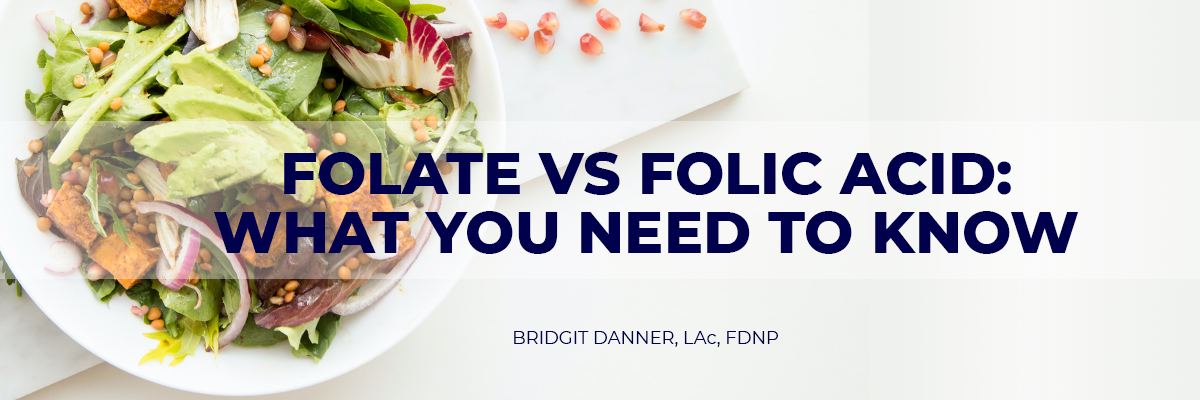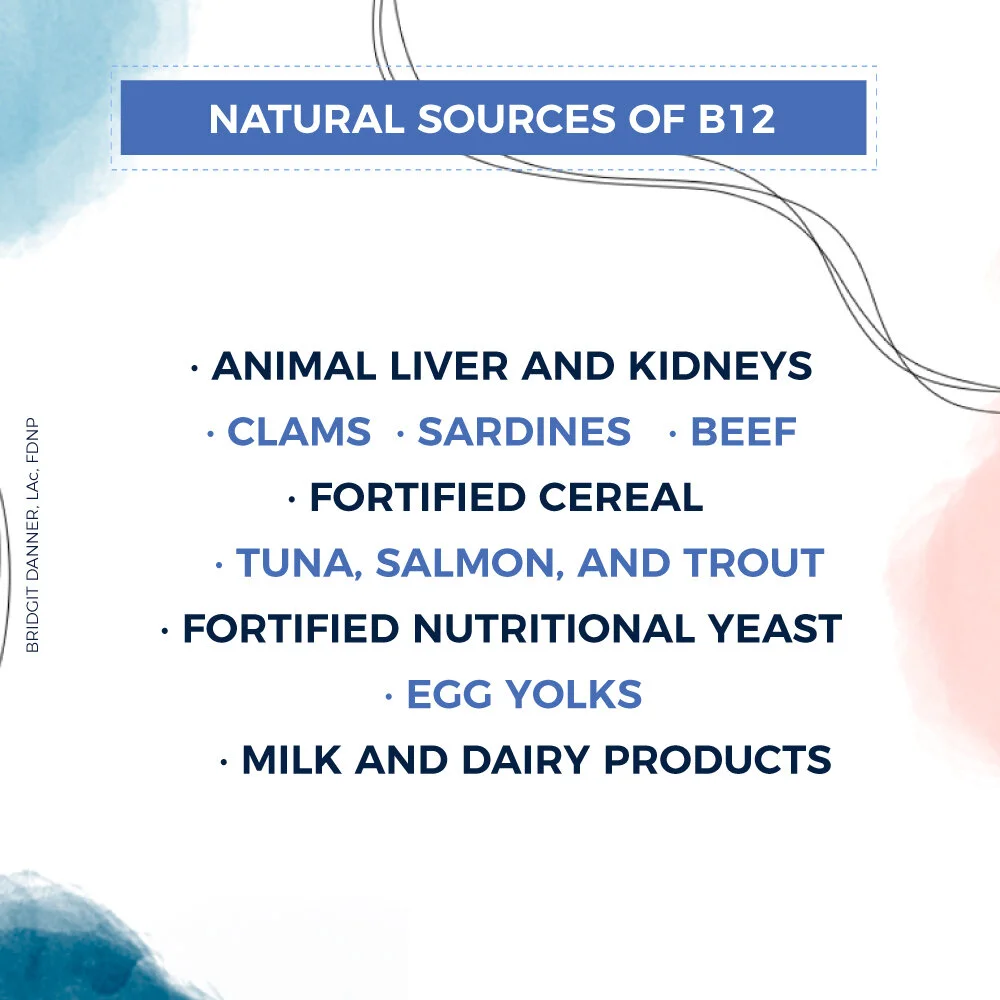Folate vs Folic Acid: What You Need to Know
Although many people use the terms interchangeably, folate and folic acid are two distinct forms of vitamin B9.
It’s crucial for you to know the differences – especially if you are pregnant or planning to become pregnant, or if you deal with any chronic health conditions.
What Is Vitamin B9 (Folate)?
Vitamin B9 is an essential nutrient that occurs naturally as folate. It serves many critical functions in the human body, including many detox processes, the formation of DNA, and cell growth.
Sources of Vitamin B9
The term “folate” comes from the Latin word “folium,” which translates as “leaf.” The name is appropriate since dark green, leafy vegetables (including kale, spinach, broccoli, and lettuce) are among the best natural sources of folate.
Other whole food sources of this active form of vitamin B9 are:
Eggs
Legumes
Brussels sprouts
Avocado
Okra
Asparagus
Fresh fruits (such as bananas, oranges, lemons, and melons)
Beans
Mushrooms
Meats (such as beef liver and kidney)
Folate vs. Folic Acid
Folate is the naturally occurring form of vitamin B9, which is found in the foods mentioned above. Folate can also be referred to as L-methylfolate or 5-MTHF or activated B9, since it is the active form.
Folic acid, on the other hand, is the synthetic, cheap-to-produce version of vitamin B9 that is often found in fortified foods, multivitamins, and certain medications.
Your body must convert folic acid to the active form, folate, to be useful for detox and other processes. As we’ll learn later on, this conversion is not always a smooth process and can be seriously delayed in those with chronic health issues.
What Is Folate’s Role in a Healthy Body?
Adequate folate intake is especially important during the body’s periods of enormous growth, such as pregnancy, infancy, and adolescence.
Folate is also a crucial building block to many of your detox processes.
Folate works as a coenzyme, helping other enzymes in the body maintain their proper levels to do their jobs. For instance, folate helps convert the compound homocysteine to methionine, an essential amino acid. Without enough folate, homocysteine levels can become too high. High homocysteine levels have been linked to infertility and miscarriages in some studies. (1)
High homocysteine levels also may lead to an increased risk of heart disease and stroke. A shortage of folate also can lead to megaloblastic anemia since folate is critical to the production of red and white blood cells and heme, the iron-rich molecule in red blood cells. (2) (3)
Folate is also used to treat many mental and physical conditions, including stroke, depression, memory loss, and impaired cognitive thinking. (4)
Folate is essential to women’s health because it helps balance mood swings, break down hormones, and promote a healthy pregnancy.
What Happens When the Body Cannot Convert Folic Acid to Folate?
MTHFR Gene Mutations
Unfortunately, many people (up to 60% of women) have a defect in a specific gene – called the MTHFR -- that converts synthetic folic acid into active methylfolate. This can be a factor in pregnancy/fertility issues, as well as in many chronic health conditions.
If you have this gene variation, your body cannot quickly convert folic acid (the synthetic form) to folate. This is why some people who take folic acid as a supplement may not absorb their B vitamins as expected.
MTHFR variants are found in people all over the world. More than 25% of the Latino population have variants in the gene. Between 10 percent to 15 percent of the Caucasian population, and a study on pregnant Chinese women found that nearly one in three had two MTHFR variants. (5, 6)
Problems with Slow Conversion of Folic Acid to Folate
Since 1998, federal law has required folic acid to be added to cold breakfast cereals, bread, bakery items, cookies, crackers, flour, and pasta. If you eat these fortified foods and take a supplement, you may end up with too much folic acid in your system.
Before folate enters your bloodstream, your digestive system converts it into the active form of vitamin B9, or 5-MTHF. However, this conversion process is more complicated and takes a longer time when it comes to the synthetic folic acid.
In some people, unmetabolized folic acid can build up in the bloodstream, leading to health problems, including an increased cancer risk and vitamin B12 deficiency. An untreated vitamin B12 deficiency is associated with impaired nerve function and increased risk for memory loss and dementia. (7, 8, 9)
A diet with too much folic acid may lower brain development and cause insulin resistance in some children. In one study, 4- and 5-year-old children whose mothers supplemented with over 1,000 mcg of daily folic acid while they were pregnant had lower scores on brain development tests than the children of women who took 400–999 mcg each day. (10)
Additionally, vitamin B9 is a crucial player in your detox processes. If your body is unable to get enough activated B9, this will impair your body’s efforts at detox.
Although folic acid is generally considered safe, there can be problems with consuming too much, as we have seen. There are some instances when folic acid can interfere with medications you are already taking. I recommend that you speak with your healthcare provider before taking a folic acid supplement.
Why Moms-to-Be Need to Be Careful
Vitamin B9 plays a vital role in conception, pregnancy, and the health of an infant. Since a vitamin B9 deficiency has been connected with an increased risk of miscarriage and neural tube defects, obstetricians have encouraged their patients to watch their levels during pregnancy.
The Centers for Disease Control (CDC) recommend that women in their reproductive years consume 400 mcg of folic acid daily as well as foods with folate to help prevent neural tube defects.
The most common types of these neural tube defects are anencephaly and spina bifida. Spina bifida is a condition in which the bones of the spine do not completely close around the spinal cord. In anencephaly, parts of the brain or skull may be missing or deformed. (11)
What is not well known is that 25 and 60 percent of the population have a gene variation that limits their ability to convert synthetic folic acid into the active form of folate. Women who are at an increased risk of having the variation include those who have:
a blood test revealing high levels of homocysteine
a close family member who has a confirmed MTHFR mutation
a personal or family history of heart disease or blood vessel disorders (12)
Women who are hoping to become pregnant can take a blood test to find out if they have the MTHFR variation. These test results will help you make informed choices about your nutritional needs for yourself and your baby.
What Are the Healthiest Sources of Vitamin B9?
The best dietary sources of vitamin B9 are whole foods, such as leafy green vegetables and the other whole foods we mentioned earlier in this blog.
However, many people do not get enough vitamin B from diet alone. That is why I always recommend taking a B-vitamin supplement that has methylfolate and not folic acid. Since a methylfolate supplement is already in the active form, you don’t have to have the MTHFR enzyme for your body to convert it to folate right away.
So, why do most multivitamins contain folic acid rather than methylfolate? The answer is cost. I recently discovered that methylfolate costs about $12,000 per kg! Conversely, folic acid is a relatively inexpensive ingredient that is part of most over-the-counter folate supplements.
However, if you have the gene variation (MTHFR) that impacts your absorption of folic acid – or even if you don’t -- the extra cost of methylated folate may be well worth it. I recommend you discuss methylfolate supplementation with your health practitioner.
While natural food sources are always a good choice, you might opt to take a prenatal or multivitamin containing methylfolate to prevent deficiencies.
Methylfolate (the active form of B9) shows up on the label as one of the following terms:
L-methylfolate
L-5-MTHF
5-MTHF
Metafolin
If you plan to supplement to avoid deficiency, I recommend that you take your vitamin B9 as part of a quality multivitamin. That’s why I love to recommend the multivitamin I chose to carry in my shop: Hi-Potency Multivitamin.
This supplement contains B vitamins in their active forms. Just as B9 has an active form (folate) and an inactive form (folic acid), so the other B vitamins do as well. It’s important for your body to get all the B vitamins in an active form.
What Are Good Sources of B12?
B12 is another B complex vitamin that interacts heavily with vitamin B9. It’s important to get enough of both of these vitamins!
It’s important to get a quality source of B12, so make sure to avoid products that contain cyanocobalamin. It is a synthetic form of B12, and it is an inexpensive ingredient that is poorly absorbed by the body.
Here are some natural sources of B12:
Animal liver and kidneys
Clams
Sardines
Beef
Fortified cereal
Tuna, salmon, and trout
Fortified nutritional yeast
Egg yolks
Milk and dairy products
Our Hi-Potency Multivitamin is a fantastic way to make sure you get the optimal amounts of nutrients that are not easily obtained in most diets. Our multivitamin contains both methylated folate (B9) and methylated B12.
Conclusion
If you’d like to read more about the steps for choosing a multivitamin, please read my recent blog on the topic.
I hope that after reading this blog that you now know more about the importance of vitamin B9 and the difference between folate and folic acid. As I have mentioned in my blogs and to my clients many times, your best bet is to get your vitamins through a whole foods diet and targeted supplementation.
Bridgit Danner, LAc, FDNP, is an acupuncturist turned functional health coach and has worked with thousands of clients since 2004.
She is the founder of FunctionalDetoxProducts.com and the author of The Ultimate Guide to Toxic Mold Recovery: Take Back Your Home Health & Life, available in audiobook, Kindle and paperback on Amazon.













The thought of a coffee enema might leave you in shock, but it’s actually a practice that has been used for thousands of years. I’ve seen the correct implementation of coffee enemas truly transform energy, gut health, antioxidant status and more. Learn the right way to do a coffee enema!